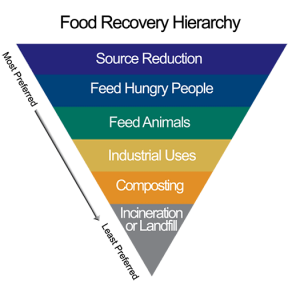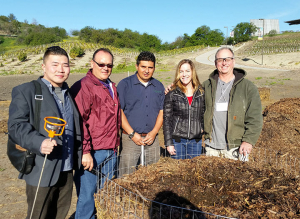 When developing any type of food waste reduction plan, the IWRC highly recommends referring to the U.S. EPA's Food Recovery Hierarchy. It can serve as a roadmap for the best methods at reducing food waste and diverting it from landfills.
When developing any type of food waste reduction plan, the IWRC highly recommends referring to the U.S. EPA's Food Recovery Hierarchy. It can serve as a roadmap for the best methods at reducing food waste and diverting it from landfills.
Earlier this month, one of our environmental specialists, Jenny Trent, escaped the Iowa winter and traveled to California to learn more about the fifth category by attending a U.S. Composting Council Compost Operations Training Course.
 The five day program focused on the knowledge and skills needed to run a successful composting facility. Curriculum included the composting process; site design and environmental controls; site visits and regulations; product quality; and lastly facility management and troubleshooting.
The five day program focused on the knowledge and skills needed to run a successful composting facility. Curriculum included the composting process; site design and environmental controls; site visits and regulations; product quality; and lastly facility management and troubleshooting.
“I learned an amazing amount of information about composting," says Trent. "My favorite part of the course was the team I worked with to make a compost pile measuring two cubic yards. We had to add the right feedstocks to achieve the best recipe that took into account moisture, bulk density, porosity, nitrogen, carbon, and temperature."
The group used used one part horse manure, cattle manure, green grass, horse bedding, and 1.2 parts of dry landscape waste, and then added about 20 gallons of water to the pile. Then very morning the temperature and oxygen percent was measured throughout the pile. "Our compost pile reached 170°F and the oxygen percent was adequate for the needs of the beneficial bacteria and fungi busy breaking down the material," Trent explains.
Then on the last day of the course, the group got to tear into their compost pile. "It was intolerably hot, but we could see the feedstocks were already decomposing and found evidence of actinomycetes, a beneficial white bacteria that prefers the cooler temperature of the edges and breaks down cellulose such as wood chips and hay.” says Trent.
From Resources to Setting Up a Compost Pile
Trent has been at the forefront of IWRC’s efforts to reduce food waste and divert it from the landfill over the past couple years and hopes this latest endeavor to know more about compost operations will allow her to be able to provide more insight and assistance to entities throughout the state that want to start compost operations but simply don’t know where to begin.
“To start your own compost pile, it’s best to begin with about three parts carbon to one part nitrogen. Carbon really is important to keeping the pile healthy, stink-free and full of oxygen," she explains. Items like shredded cardboard, wood chips, and dry leaves make great carbon feedstocks; wood chips especially because they add pore space to your pile and allow for more oxygen to feed the bacteria and fungi. Nitrogen rich feedstocks include food waste, garden waste and green grass. "Basically, anything green makes a good nitrogen source," she explains.
 Water is also an important feature to the compost pile throughout the whole curing process. Anywhere between 45-60% moisture is adequate. When you squeeze a handful of compost, drips of water are a good indication your compost is wet enough, but it shouldn’t be so wet it streams water with a squeeze.
Water is also an important feature to the compost pile throughout the whole curing process. Anywhere between 45-60% moisture is adequate. When you squeeze a handful of compost, drips of water are a good indication your compost is wet enough, but it shouldn’t be so wet it streams water with a squeeze.
Next, turn the pile with a pitchfork about once a week to redistribute the feedstocks and moisture to keep the process throughout the whole pile evenly distributed. A compost thermometer is a great tool to help ascertain how well the process is progressing. Achieving 131°F for three days will kill most pathogens and many weed seeds.
Finally, the compost needs to be fully cured before applying to plants, turf, and gardens. "Finished compost should smell sweet like dirt and not stink, and should have relatively small particles sizes. You can easily check to see if your compost is finished and fully cured by planting a few radish seeds in small pots of compost. If ¾ of the seeds sprout and grow into healthy looking radishes, then your compost is finished and can be used.” Trent concludes.
What's To Come
Over the next few months, we will have much more to share with you! But in the meantime, have you started your own compost operations? Head over to our Facebook page and tell us all about it!

